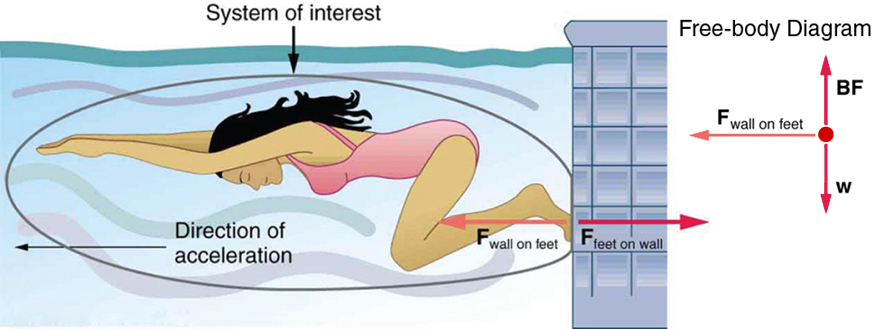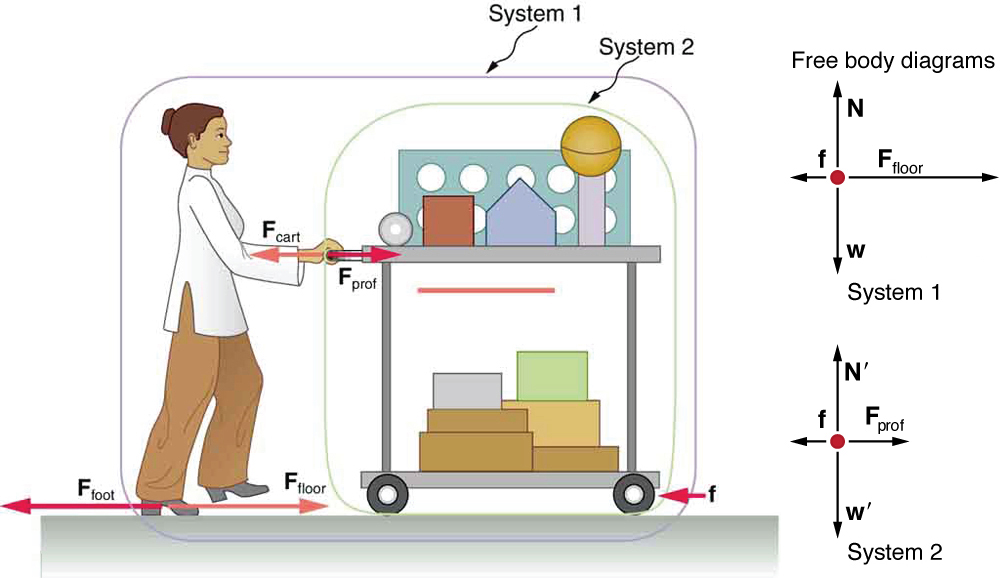39 6.4 Newton’s Third Law of Motion: Symmetry in Forces
Summary
- Understand Newton’s third law of motion.
- Apply Newton’s third law to define systems and solve problems of motion.
There is a passage in the musical Man of la Mancha that relates to Newton’s third law of motion. Sancho, in describing a fight with his wife to Don Quixote, says, “Of course I hit her back, Your Grace, but she’s a lot harder than me and you know what they say, ‘Whether the stone hits the pitcher or the pitcher hits the stone, it’s going to be bad for the pitcher.’” This is exactly what happens whenever one body exerts a force on another—the first also experiences a force (equal in magnitude and opposite in direction). Numerous common experiences, such as stubbing a toe or throwing a ball, confirm this. It is precisely stated in Newton’s third law of motion.
NEWTON’S THIRD LAW OF MOTION
Whenever one body exerts a force on a second body, the first body experiences a force that is equal in magnitude and opposite in direction to the force that it exerts.
This law represents a certain symmetry in nature: Forces always occur in pairs, and one body cannot exert a force on another without experiencing a force itself. We sometimes refer to this law loosely as “action-reaction,” where the force exerted is the action and the force experienced as a consequence is the reaction. Newton’s third law has practical uses in analyzing the origin of forces and understanding which forces are external to a system.
We can readily see Newton’s third law at work by taking a look at how people move about. Consider a swimmer pushing off from the side of a pool, as illustrated in Figure 1. She pushes against the pool wall with her feet and accelerates in the direction opposite to that of her push. The wall has exerted an equal and opposite force back on the swimmer. You might think that two equal and opposite forces would cancel, but they do not because they act on different systems. In this case, there are two systems that we could investigate: the swimmer or the wall. If we select the swimmer to be the system of interest, as in the figure, then Fwall on feet is an external force on this system and affects its motion. The swimmer moves in the direction of Fwall on feet. In contrast, the force Ffeet on wall acts on the wall and not on our system of interest. Thus Ffeet on wall does not directly affect the motion of the system and does not cancel Fwall on feet. Note that the swimmer pushes in the direction opposite to that in which she wishes to move. The reaction to her push is thus in the desired direction.

Other examples of Newton’s third law are easy to find. As a professor paces in front of a whiteboard, she exerts a force backward on the floor. The floor exerts a reaction force forward on the professor that causes her to accelerate forward. Similarly, a car accelerates because the ground pushes forward on the drive wheels in reaction to the drive wheels pushing backward on the ground. You can see evidence of the wheels pushing backward when tires spin on a gravel road and throw rocks backward. A professional cage fighters experience reaction forces when they punch, sometimes breaking their hand by hitting an opponent’s body.
Example 1: Getting Up To Speed: Choosing the Correct System
A biomechanics professor pushes a cart of demonstration equipment to a lecture hall, as seen in Figure 2. Her mass is 65.0 kg, the cart’s is 12.0 kg, and the equipment’s is 7.0 kg. Calculate the acceleration produced when the professor exerts a backward force of 150 N on the floor. All forces opposing the motion, such as friction on the cart’s wheels and air resistance, total 24.0 N.

Strategy
Since they accelerate as a unit, we define the system to be the professor, cart, and equipment. This is System 1 in Figure 2. The professor pushes backward with a force Ffoot of 150 N. According to Newton’s third law, the floor exerts a forward reaction force Ffloor of 150 N on System 1. Because all motion is horizontal, we can assume there is no net force in the vertical direction. The problem is therefore one-dimensional along the horizontal direction. As noted, f opposes the motion and is thus in the opposite direction of Ffloor. Note that we do not include the forces Fprof or Fcart because these are internal forces, and we do not include Ffoot because it acts on the floor, not on the system. There are no other significant forces acting on System 1. If the net external force can be found from all this information, we can use Newton’s second law to find the acceleration as requested. See the free-body diagram in the figure.
Solution
Newton’s second law is given by
The net external force on System 1 is deduced from Figure 2 and the discussion above to be
The mass of System 1 is
These values of Fnet and m produce an acceleration of
Discussion
None of the forces between components of System 1, such as between the professor’s hands and the cart, contribute to the net external force because they are internal to System 1. Another way to look at this is to note that forces between components of a system cancel because they are equal in magnitude and opposite in direction. For example, the force exerted by the professor on the cart results in an equal and opposite force back on her. In this case both forces act on the same system and, therefore, cancel. Thus internal forces (between components of a system) cancel. Choosing System 1 was crucial to solving this problem.
Example 2: Force of the Cart—Choosing a New System
Calculate the force the professor exerts on the cart in Figure 2 using data from the previous example if needed.
Strategy
If we now define the system of interest to be the cart plus equipment (System 2 in Figure 2), then the net external force on System 2 is the force the professor exerts on the cart minus friction. The force she exerts on the cart, Fprof, is an external force acting on System 2. Fprof was internal to System 1, but it is external to System 2 and will enter Newton’s second law for System 2.
Solution
Newton’s second law can be used to find Fprof. Starting with
and noting that the magnitude of the net external force on System 2 is
we solve for Fprof, the desired quantity:
The value of f is given, so we must calculate net Fnet. That can be done since both the acceleration and mass of System 2 are known. Using Newton’s second law we see that
where the mass of System 2 is 19.0 kg (m= 12.0 kg + 7.0 kg) and its acceleration was found to be a = 1.5 m/s2 in the previous example. Thus,
Now we can find the desired force:
Discussion
It is interesting that this force is significantly less than the 150-N force the professor exerted backward on the floor. Not all of that 150-N force is transmitted to the cart; some of it accelerates the professor.
The choice of a system is an important analytical step both in solving problems and in thoroughly understanding the physics of the situation (which is not necessarily the same thing).
Section Summary
- Newton’s third law of motion represents a basic symmetry in nature. It states: Whenever one body exerts a force on a second body, the first body experiences a force that is equal in magnitude and opposite in direction to the force that the first body exerts.
Conceptual Questions
1: Describe a situation in which one system exerts a force on another and, as a consequence, experiences a force that is equal in magnitude and opposite in direction. Which of Newton’s laws of motion apply?
2: An American football lineman reasons that it is senseless to try to out-push the opposing player, since no matter how hard he pushes he will experience an equal and opposite force from the other player. Use Newton’s laws and draw a free-body diagram of an appropriate system to explain how he can still out-push the opposition if he is strong enough.
Problems & Exercises
1: A brave but inadequate rugby player is being pushed backward by an opposing player who is exerting a force of 800 N on him. The mass of the losing player plus equipment is 90.0 kg, and he is accelerating at 1.20 m/s2 backward. (a) What is the force of friction between the losing player’s feet and the grass? (b) What force does the winning player exert on the ground to move forward if his mass plus equipment is 110 kg? (c) Draw a sketch of the situation showing the system of interest used to solve each part. For this situation, draw a free-body diagram and write the net force equation.
Glossary
- Newton’s third law of motion
- whenever one body exerts a force on a second body, the first body experiences a force that is equal in magnitude and opposite in direction to the force that the first body exerts
Solutions
Problems & Exercises
1: net force on the losing player = m a = (90.0 kg)(1.20 m/s2) = 108 N. The pushing backwards force is 800 N but the net force is only 108 Ns so that means friction = (800-108) = 692 N. Without friction the net force would be 800 N and the player would accelerate very quickly backwards. b) net force on the winning player = m a = (110.0 kg)(1.20 m/s2) = 132 N. He is exerting a force of 800 N so the friction force = ?

